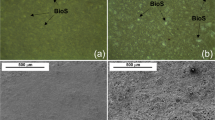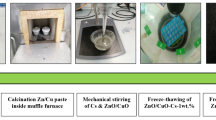Abstract
Wound treatment is one of the most prevalent concerns and economic burden in healthcare system. Because of antibacterial and re-epithelialization properties, trimethyl chitosan (TMC) has the potential to be used in wound healing dressing. Hyaluronic acid (HA), the main component of the extracellular matrix is capable to activate specific cell signals involved in fibroblast proliferation and new vessel formation, improving the quality of the scars. LL37 peptide promotes wound healing, angiogenesis and also has potential antimicrobial properties. Hence, we aimed to fabricate LL37 encapsulated in TMC-HA composite as a novel topical wound dressing and evaluated its efficacy to accelerate wound closure in an animal model. Composites were optimized based on physical properties such as, porosity, swelling, biodegradation, and mechanical properties. The release of LL37 from the optimized composite (3:3 v/v) was completed during 8 h using bicinchoninic acid assay (BCA) protein quantification kit. LL37-loaded TMC-HA composites displayed antimicrobial activity against Staphylococcus aureus and Pseudomonas aeruginosa. Animal experiments demonstrated the complete wound healing in the group that received LL37-loaded TMC-HA following 16 days of treatment. Based on histological studies, the formation of advanced granulation tissue with significantly higher collagen deposition and re-epithelialized tissues were observed in LL37-loaded TMC-HA-treated wounds. In conclusion, we successfully developed a biodegradable wound healing dressing that promoted healing processes in mice wound model contributed to simultaneous positive effects of the polymers and LL37.




Similar content being viewed by others
References
Akita S (2019) Wound repair and regeneration: mechanisms, signaling int. J Mol Sci 20:6328
Boateng J, Catanzano O (2015) Advanced Therapeutic Dressings for Effective Wound Healing—A Review. J Pharm Sci 104:3653–3680
Carretero M, Marı´a J, Escamez 1 et al (2008) In vitro and in vivo Wound Healing-Promoting activities of human cathelicidin LL-37. J Invest Dermatology 128:223–236
Chanda A, Adhikari J, Ghosh A et al (2018) Electrospun chitosan/polycaprolactone-hyaluronic acid bilayered scaffold for potential wound healing applications. 116:774–785
Chereddy K, Her C, Comune M et al (2014) PLGA nanoparticles loaded with host defense peptide LL37 promote wound healing. J Controlled Release 194:138–147
Dehkordi N, Minaiyan M, Talebi et al (2019) Nanocrystalline cellulose–hyaluronic acid composite enriched with GMCSF loaded chitosan nanoparticles for enhanced wound healing. Biomedical Materials,, p 14
Fahimirad Sh H, Sarlak N (2021) Antimicrobial Activity, Stability and Wound Healing Performances of Chitosan Nanoparticles Loaded Recombinant LL37 Antimicrobial Peptide
Garcia-Orue I, Gainza G, Girbau C (2016) LL37 loaded nanostructured lipid carriers (NLC): a new strategy for the topical treatment of chronic wounds. Eur J Pharm Biopharm 108:310–316
Ghomi E, Khalili Sh, Khorasani S, Nisiang R (2019) Wound dressings: current advances and future directions. J Appl Polym Sci 136:47738
Grönberg A, Mahlapuu M, Ståhle M et al (2014) Treatment with LL-37 is safe and effective in enhancing healing of hard-to-heal venous leg ulcers: a randomized, placebo-controlled clinical trial. Wound Rep Reg 22:613–621
Kahlenberg JM, Kaplan MJ (2013) Little peptide, big effects: the role of LL-37 in inflammation and autoimmune disease. J Immunol. 15;191:4895 – 901.
Lin J, Zhang H, Chen Z et al (2010) Penetration of lipid membranes by gold nanoparticles: insights into Cellular Uptake, cytotoxicity, and their relationship. 4:5421–5429ACS Nano
Lukas B, Hallstensson K, Ringstad L et al (2019) Cubosomes for topical delivery of the antimicrobial peptide LL-37. Eur J Pharm Biopharm 134:60–67
Mangoni M, Alison, Dermott M, Zasloff M (2016) Antimicrobial peptides and wound healing: biological and therapeutic considerations experimental dermatology. 25:167–173
Miguel S, Moreira A, Correia I (2019) Chitosan based-asymmetric membranes for wound healing: a review. Int J Biol Macromol 127:460–475
Mohandas A, Anisha KP, Chennazhi R, Jayakumar (2015) Chitosan–hyaluronic acid/VEGF loaded fibrin nanoparticles compositesponges for enhancing angiogenesis in wounds. Colloids Surf B 127:105–113
Murphy P, Evans G (2012) Advances in Wound Healing: a review of current wound Healing Products. https://doi.org/10.1155/2012/190436. Plastic surgery international
Nathan C (2020) Resisting antimicrobial resistance. Nat Rev Microbio l18:259–260
Neuma M, Nanau R, Oruña-Sanchez L (2015) Hyaluronic Acid and Wound Healing. J Pharm Pharm Sci 18:53–60
Pivodová V, Franková J, Galandáková A et al (2015) Vitro AuNPs’ cytotoxicity and their. Effect on Wound Healing, Nanobiomedicine
Ramosa R, Silva J, Rodriguesa A et al (2011) Wound healing activity of the human antimicrobial peptide LL37, peptides. 32:1469–1476
Rezazadeh M, Akbari V, Amuaghae E, Emami J (2018a) Preparation and characterization of an injectable thermosensitive hydrogel for simultaneous delivery of paclitaxel and doxorubicin. Res Pharm Sci 13:181
Rezazadeh M, Jafari N, Akbari V (2018b) A mucoadhesive thermosensitive hydrogel containing erythropoietinmas a potential treatment in oral mucositis: in vitro and in vivo studies drug delivery and Translational Research. 8:1226–1237
Saporito P, Mouritzen M, Olesen A et al (2018) LL-37 fragments have antimicrobial activity against Staphylococcus epidermidis biofilms and wound healing potential in HaCaT cell lineJ Pep Sci.;e3080
Teh B, Shen Y, Friedland L (2012) A review on the use of hyaluronic acid in tympanic membrane wound healing Expert Opinion on Biological Therapy. 12:23–36
Thapa R, Diep D, Tønnesen H (2020) Topical antimicrobial peptide formulations for wound healing: current developments and future prospects. Acta Biomater 103:52–67
Zheng Z, Dong Y, Cheng X (2016) Biomaterials based on N,N,N-trimethyl chitosan fibers in wound dressing applications. Int J Biol Macromol 89:471–476
Author information
Authors and Affiliations
Corresponding author
Additional information
Publisher’s Note
Springer Nature remains neutral with regard to jurisdictional claims in published maps and institutional affiliations.
Rights and permissions
Springer Nature or its licensor (e.g. a society or other partner) holds exclusive rights to this article under a publishing agreement with the author(s) or other rightsholder(s); author self-archiving of the accepted manuscript version of this article is solely governed by the terms of such publishing agreement and applicable law.
About this article
Cite this article
Rezazadeh, M., Jalali, I., Akbari, V. et al. Preparation and Characterization of Trimethyl Chitosan /Hyaluronic Acid Composite Encapsulated with LL37 to Promote Wound Healing in an Animal Model. Int J Pept Res Ther 29, 43 (2023). https://doi.org/10.1007/s10989-023-10513-6
Accepted:
Published:
DOI: https://doi.org/10.1007/s10989-023-10513-6




